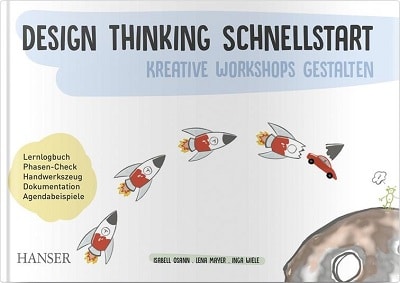Learning leadership through facilitation
My career as a facilitator started more than ten years ago in a Design Thinking training. While I thought I was there to become more creative, the training was the spark for my journey into the world of facilitation and leadership.
I learned an approach where one step builds on the other and each step is supported by the use of methods. And as part of this training, I facilitated for the first time – completely without guidance.
To be honest, facilitating in the training totally overwhelmed me and the first workshops I facilitated were also rather amateurish. Some of my peers who had gone through the same training struggled just as much.
I thought the facilitator was responsible for EVERYTHING: preparing, thinking ahead, explaining process and methods, collaborating, thinking along, documenting, presenting. And if the participants are dissatisfied with the result at the end, that is of course the facilitator’s fault alone. It was exhausting and psychologically stressful.
Thank God I didn’t have to moderate every day.
Innate talents and the meta-level
It may sound illogical – but I continued to moderate despite the stresses that came with it, and I was also frequently asked to moderate. People thought I was a “born” moderator and I was flattered by that. So I continued and even became a trainer in the Design Thinking curriculum in my company. I went on to teach others how to facilitate within the framework of Design Thinking. And to be honest, I still didn’t really know anything about it. And maybe that was my luck.
In this training, I observed other people facilitating.
I had landed on the meta-level without ever having heard the term.
Things went uphill from there.
Together with other trainers, I analysed observations and together we found patterns and tips on how good facilitation works.
Finding: You are facilitating much more than Design Thinking or creativity – you are facilitating leadership!
Facilitation and Design Thinking became my passion and my business model. In 2014, I held my first open Design Thinking training for the company gezeitenraum, which I had founded together with my husband Christian in 2012.
In the course of this training, I received feedback that has since summed up my work and my understanding of facilitation – a seasoned entrepreneur said to me:
“What you are facilitating here goes far beyond creativity – it is leadership training. I have understood through your training that I should moderate much more as a leader. Facilitation forces me to listen to my staff and give them space. And I’m learning that results are good even if I haven’t contributed to the content.”
This feedback has stuck with me to this day. For me, facilitation is the best leadership training.
What do facilitation and leadership have in common?
A blog post is of course no training, but I will try to outline my most important findings about the similarities between facilitation and leadership here:
- Creating a setting within which each team member can optimally contribute their strengths and potentials.
- Giving clear mandates and yet allowing openness to results.
- The ability to tolerate holding back on content.
- Creating a balance between different characters in the team.
- Taking the next step in uncertain situations, even if not everything seems clear yet.
- Plan for conflicts instead of being surprised by them.
- Encourage the team to take action and, in case of doubt, to fail quickly.
- Delegate decisions.
- Be responsible without wanting to make all the decisions yourself.
- Constantly give, accept and reflect on feedback.
How can the leader be trained through facilitation?
- First try out facilitation according to the cookbook, e.g. with a sequence of steps with assigned methods such as in Design Thinking.
- Limit the duration of the moderations. Start with short phases and gradually increase the duration.Make facilitation tasks playful, e.g. by designing a new parlour game together with colleagues in two hours.
- Try out facilitation in a private environment, e.g. by planning a holiday programme together with your family.
- Increase the importance of the tasks as you gain experience.
- From time to time, consciously watch others facilitating/leading and derive insights and suggestions from this.
- Find your own style and question it regularly.
- Use the feedback from the last workshop as a stimulus/experiment for your next workshop.
My most important tips for moderators and leaders
1. Feedback is your daily bread.
Good facilitation and good leadership only work when teams have the opportunity to get into the groove. And for that you need feedback. Not once a year but constantly. Not always functional, but also picked up from comments in passing. You don’t have to implement all feedback, but you do have to accept it. The same applies to your team.
2. In uncertain situations, both the goal and the path are unknown.
Your role is not to pretend that you already know all the answers, but to provide confidence that you can navigate teams safely and forward through such situations.
3. You are responsible for creating structures that your team members then fill with content.
These structures can be found in temporary spaces such as meetings and workshops, as well as in longer running projects or routine tasks. Structures are e.g. agenda, time planning, structure of steps, methods, prepared templates.
4. Stay flexible.
Not everything can be planned exactly past. Plan buffers for detours and conflicts. If in doubt, throw your plan overboard and plan together with your team. Ideally, everyone in your team should be able to moderate at least rudimentarily.
5. Don’t take anything for granted.
Always create opportunities to establish a common understanding.
6. Bring in your own content – but weigh up well when it is the right time to do so.
Be aware that many people tend to judge their own ideas as “wrong” as soon as other people (especially leaders) have expressed a direction. Sometimes it also takes patience – things that you yourself have in mind are often voiced by the team only a short time later. Note down your own ideas and only contribute them if they do not come from the team itself.
7. As often as possible, let team members write down their own thoughts before speaking.
This way you get the full spectrum of ideas. It also allows introverts to have their say.
8. Always conduct and create space for real exchange.
In workshops as well as in routine situations, it happens that people take up different amounts of space. This is perfectly okay, because we need very different characters, just as an orchestra needs louder and quieter instruments and not all of them are used equally often (triangle, timpani vs. trumpets and violins). Your role is to identify and control the times when space is needed for the different impulses.
9. You are responsible for everything, but you rely on your team and let them make their own decisions.
This is perhaps the most difficult point. A manager once said: “Yes, everyone wants to have a say, but in the end I have to take the rap for it.” I’ll let Steve Jobs answer that: “It doesn’t make sense to hire smart people and then tell them what to do. We hire smart people so they can tell us what to do.”
Let’s be honest – when have you had to take the rap more often – when you made all the decisions yourself or when your carefully selected and experienced staff did? (If in doubt, you are still left with point 1 and point 6).
10. Fail fast instead of fail big.
Fail fast is about trying to prevent a fail big. And it’s about getting back into action, trying things out and moving forward, even if not everything is clear yet.
Concluding thoughts and quintessence
When facilitation and leadership feel easy, it is never innate. It is the result of a lot of practice and self-reflection.
In my “best” facilitations, I feel more like an observer, almost invisibly following what is happening. I then intervene intuitively and try to be minimally invasive.
I am still in contact with the entrepreneur who introduced me to the connection between Design Thinking, facilitation and leadership. Two weeks after the training, he called me and said: “You made it all feel so logical and easy. My first own attempt at moderation was pretty intense and totally cerebral. I guess I still need to practise.”
Most of what I have learned about facilitation and leadership over the years comes from my own experiments, sharing and observing with and from other great facilitators, and reading many books on facilitation and leadership.
My quintessence from this is:
“Everything gets easier with shared direction, inspiration and ever-changing moments of moving forward. Understand what makes your team tick, how to find creative solutions together and shape your path together.”
Notes:
You can book Inga Wiele as a facilitator and trainer if you need someone to help you move forward again. Or if you want to learn how to strengthen your own leadership through facilitation.
Here you can find dates for trainings (in German) on “Design Thinking” and “Moderation entlang von Design Thinking”.
And if you are looking for a good structure and inspiring methods for workshops, the German book “Design Thinking Schnellstart“, co-authored and illustrated by Inga Wiele, is definitely very useful.
Inga Wiele has published another post on the t2informatik Blog:

Inga Wiele
Inga Wiele loves to encourage people to embark on new paths. In doing so, she understands how to recognise the different perspectives of those involved and how to encourage teams. She meets obstacles with the analysis to skilfully counter-strategy – always with the goal in mind of getting the course back on track.
Inga studied business administration at the Stuttgart University of Cooperative Education. Several years of experience as a software consultant in Germany and in Boston/USA have taught her to quickly understand contexts and enabled her to drive customer-oriented product innovations at SAP, where she worked for almost 14 years. During this time, she was also a member of the Supervisory Board of SAP AG for two years.
In 2011, Inga was trained as a design thinking coach at the d.school of the Hasso Plattner Institute in Potsdam and was actively involved as a project coach and trainer in the roll-out of this working method at SAP AG.
Since 2014, she has been self-employed as managing director of the company gezeitenraum, which she founded with her husband Christian. In Sankt Peter-Ording, they both realise their dream of living by the sea and weathering storms. In the meantime, gezeitenraum has been named one of the best management consultancies seven times by brand eins and statista.

